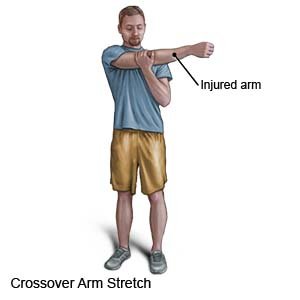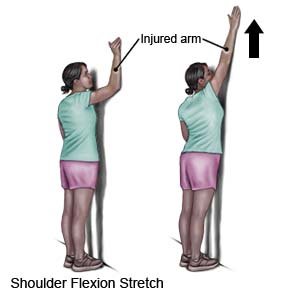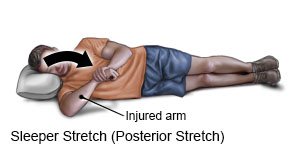Exercises for Shoulder Flexion and Extension
Medically reviewed by Drugs.com. Last updated on Apr 6, 2025.
Shoulder flexion and extension exercises work the muscles in your upper back.
DISCHARGE INSTRUCTIONS:
Call your doctor or physical therapist if:
- You have sharp or worsening pain during exercise or at rest.
- You have questions or concerns about your shoulder exercises.
Before you exercise:
Warm up and stretch before you exercise. Walk or ride a stationary bike for 5 to 10 minutes to help you warm up. Stretching helps increase range of motion. It may also decrease muscle soreness and help prevent another injury. Your healthcare provider will tell you which of the following stretches to do:
- Crossover arm stretch: Relax your shoulders. Hold your upper arm with the opposite hand. Pull your arm across your chest until you feel a stretch. Hold the stretch for 30 seconds. Return to the starting position.

- Shoulder flexion stretch: Stand facing a wall. Slowly walk your fingers up the wall until you feel a stretch. Hold for 30 seconds. Return to the starting position.

- Sleeper stretch: Lie on your side on a firm, flat surface with your injured arm tucked under you. Place your head on a pillow for comfort. Bend the elbow of your injured arm 90°. Use your arm that is not injured to slowly push your injured arm down. Stop when you feel a stretch at the back of your injured shoulder. Hold for 30 seconds. Slowly return to the starting position.

How to exercise with a weight:
Your healthcare provider will tell you how much weight to use.
- Shoulder extension: Lie on a hard table on your stomach. Let your arms hang off the side. Hold a weight in both hands with your palms facing toward your body. Keep your arms straight and slowly raise your arms parallel to the floor in a "Y" shape. Stop when your arms are level with your body. Hold for as long as directed. Slowly return to the starting position.
- Shoulder flexion: Stand and hold a weight in the hand of your injured shoulder. Keep your arm straight and slowly raise your arm over your head as far as you can without pain. Do not raise your arm over your head unless your healthcare provider says it is okay. Do not let your shoulder shrug. Hold this position for as many seconds as directed. Slowly return to the starting position.
How to exercise with an exercise band:
Your healthcare provider or physical therapist will tell you how much resistance to use.
- Shoulder extension: Wrap the exercise band around a heavy, stable object. The band should be level with your chest. Stand and hold each end of the band in both hands. Step back and extend your arms straight. Squeeze your shoulder blades together and pull your arms back and down. Hold for as long as directed. Slowly return to the starting position.
- Shoulder flexion: Wrap the exercise band around a heavy, stable object near your foot. Grab the band with the hand of your injured shoulder. Keep your arm straight. Slowly pull the band up and past your head as far as you can without pain. Do not raise your arm over your head unless your healthcare provider says it is okay. Do not let your shoulder shrug. Hold this position for as many seconds as directed. Slowly return to the starting position.
Follow up with your doctor or physical therapist as directed:
Write down your questions so you remember to ask them during your visits.
© Copyright Merative 2025 Information is for End User's use only and may not be sold, redistributed or otherwise used for commercial purposes.
The above information is an educational aid only. It is not intended as medical advice for individual conditions or treatments. Talk to your doctor, nurse or pharmacist before following any medical regimen to see if it is safe and effective for you.
Learn more about Exercises for Shoulder Flexion and Extension
Care guides
Further information
Always consult your healthcare provider to ensure the information displayed on this page applies to your personal circumstances.
